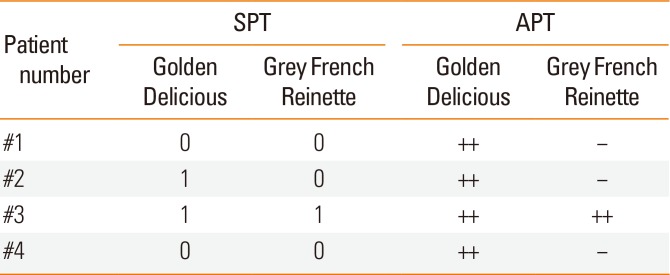1. Vegro M, Eccher G, Populin F, Sorgato C, Savazzini F, Pagliarani G, et al. Old apple (Malus domestica L. Borkh) varieties with hypoallergenic properties: an integrated approach for studying apple allergenicity. J Agric Food Chem. 2016; 64:9224–9236. PMID:
27933989.

2. Bohle B, Zwölfer B, Heratizadeh A, Jahn-Schmid B, Antonia YD, Alter M, et al. Cooking birch pollen-related food: divergent consequences for IgE- and T cell-mediated reactivity
in vitro and
in vivo. J Allergy Clin Immunol. 2006; 118:242–249. PMID:
16815162.
3. Jahn-Schmid B, Radakovics A, Lüttkopf D, Scheurer S, Vieths S, Ebner C, et al. Bet v 1142-156 is the dominant T-cell epitope of the major birch pollen allergen and important for cross-reactivity with Bet v 1-related food allergens. J Allergy Clin Immunol. 2005; 116:213–219. PMID:
15990797.

4. Wagner A, Szwed A, Buczyłko K, Wagner W. Allergy to apple cultivars among patients with birch pollinosis and oral allergy syndrome. Ann Allergy Asthma Immunol. 2016; 117:399–404. PMID:
27593099.

5. Smole U, Bublin M, Radauer C, Ebner C, Breiteneder H. Mal d 2, the thaumatin-like allergen from apple, is highly resistant to gastrointestinal digestion and thermal processing. Int Arch Allergy Immunol. 2008; 147:289–298. PMID:
18617748.

6. Cudowska B, Kaczmarski M, Restani P. Lipid transfer protein in diagnosis of birch-apple syndrome in children. Immunobiology. 2008; 213:89–96. PMID:
18241693.

7. Gomez F, Aranda A, Campo P, Diaz-Perales A, Blanca-Lopez N, Perkins J, et al. High prevalence of lipid transfer protein sensitization in apple allergic patients with systemic symptoms. PLoS One. 2014; 9:e107304. PMID:
25210741.

8. García BE, González-Mancebo E, Barber D, Martín S, Tabar AI, Díaz de Durana AM, et al. Sublingual immunotherapy in peach allergy: monitoring molecular sensitizations and reactivity to apple fruit and Platanus pollen. J Investig Allergol Clin Immunol. 2010; 20:514–520.
9. Guhsl EE, Hofstetter G, Lengger N, Hemmer W, Ebner C, Fröschl R, et al. IgE, IgG4 and IgA specific to Bet v 1-related food allergens do not predict oral allergy syndrome. Allergy. 2015; 70:59–66. PMID:
25327982.

10. Matthes A, Schmitz-Eiberger M. Apple (Malus domestica L. Borkh.) allergen Mal d 1: effect of cultivar, cultivation system, and storage conditions. J Agric Food Chem. 2009; 57:10548–10553. PMID:
19845340.

11. Nybom H, Cervin-Hoberg C, Andersson M. Oral challenges with four apple cultivars result in significant differences in oral allergy symptoms. Int Arch Allergy Immunol. 2013; 161:258–264. PMID:
23548468.

12. Reekers R, Busche M, Wittmann M, Kapp A, Werfel T. Birch pollen-related foods trigger atopic dermatitis in patients with specific cutaneous T-cell responses to birch pollen antigens. J Allergy Clin Immunol. 1999; 104:466–472. PMID:
10452773.

13. Schimek EM, Zwölfer B, Briza P, Jahn-Schmid B, Vogel L, Vieths S, et al. Gastrointestinal digestion of Bet v 1-homologous food allergens destroys their mediator-releasing, but not T cell-activating, capacity. J Allergy Clin Immunol. 2005; 116:1327–1333. PMID:
16337467.

14. Incorvaia C, Fuiano N, Canonica GW. Seeking allergy when it hides: which are the best fitting tests? World Allergy Organ J. 2013; 6:11. PMID:
23815816.

15. Wollenberg A, Vogel S. Patch testing for noncontact dermatitis: the atopy patch test for food and inhalants. Curr Allergy Asthma Rep. 2013; 13:539–544. PMID:
23857067.

16. Yehia AF, Saleh M, Ahmed AH. An adjusted correlation coefficient for canonical correlation analysis. J Egypt Stat Soc. 2016; 1–5.
17. Fernández-Rivas M, Bolhaar S, González-Mancebo E, Asero R, van Leeuwen A, Bohle B, et al. Apple allergy across Europe: how allergen sensitization profiles determine the clinical expression of allergies to plant foods. J Allergy Clin Immunol. 2006; 118:481–488. PMID:
16890775.

18. Cudowska B, Kaczmarski M. Atopy patch test in the diagnosis of food allergy in children with gastrointestinal symptoms. Adv Med Sci. 2010; 55:153–160. PMID:
21084256.

19. Kitzmüller C, Zulehner N, Roulias A, Briza P, Ferreira F, Faé I, et al. Correlation of sensitizing capacity and T-cell recognition within the Bet v 1 family. J Allergy Clin Immunol. 2015; 136:151–158. PMID:
25670010.

20. Ramb-Lindhauer C, Feldmann A, Rotte M, Neumann C. Characterization of grass pollen reactive T-cell lines derived from lesional atopic skin. Arch Dermatol Res. 1991; 283:71–76. PMID:
1712577.

21. van Reijsen FC, Bruijnzeel-Koomen CA, Kalthoff FS, Maggi E, Romagnani S, Westland JK, et al. Skin-derived aeroallergen-specific T-cell clones of Th2 phenotype in patients with atopic dermatitis. J Allergy Clin Immunol. 1992; 90:184–193. PMID:
1380019.
22. Kerschenlohr K, Decard S, Przybilla B, Wollenberg A. Atopy patch test reactions show a rapid influx of inflammatory dendritic epidermal cells in patients with extrinsic atopic dermatitis and patients with intrinsic atopic dermatitis. J Allergy Clin Immunol. 2003; 111:869–874. PMID:
12704371.

23. Cudowska B, Kaczmarski M. Atopy patch test in the diagnosis of food allergy in children with atopic eczema dermatitis syndrome. Rocz Akad Med Bialymst. 2005; 50:261–267. PMID:
16358980.
24. Fuiano N, Diddi G, Delvecchio M, C CI. Prevalence of positive atopy patch test in an unselected pediatric population. Clin Mol Allergy. 2015; 13:2. PMID:
25954139.

25. Darsow U, Laifaoui J, Kerschenlohr K, Wollenberg A, Przybilla B, Wüthrich B, et al. The prevalence of positive reactions in the atopy patch test with aeroallergens and food allergens in subjects with atopic eczema: a European multicenter study. Allergy. 2004; 59:1318–1325. PMID:
15507101.

26. Fuiano N, Incorvaia C, Prodam F, Procaccini DA, Bona G. Relationship between the atopy patch test and clinical expression of the disease in children with atopic eczema/dermatitis syndrome and respiratory symptoms. Ann Allergy Asthma Immunol. 2008; 101:174–178. PMID:
18727473.

27. Fuiano N, Fusilli S, Incorvaia C. House dust mite-related allergic diseases: role of the skin prick test, atopy patch test, and RAST in the diagnosis of different manifestations of allergy. Eur J Pediatr. 2010; 169:819–824. PMID:
19997746.






 PDF
PDF ePub
ePub Citation
Citation Print
Print


 XML Download
XML Download